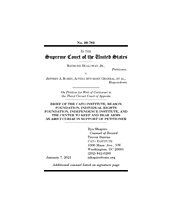In 2005, Raymond Holloway, Jr. pled guilty to driving under the influence, a misdemeanor under Pennsylvania law. Because Holloway had an earlier misdemeanor DUI, the 2005 offense was punishable by up to five years’ imprisonment. U.S. law prohibits anyone convicted of a misdemeanor crime punishable by more than two years’ imprisonment from possessing any firearm or ammunition.
Since his 2005 DUI conviction, Holloway has been an upstanding, law-abiding citizen with no other criminal convictions. He would like to own a firearm for self-defense, so he sued in federal court, arguing that the categorical prohibition of firearms possession was unconstitutional as applied to him, a non-violent offender. The district court sided with him, finding that he presented no special danger to the public and that his 15 years of lawful, virtuous behavior demonstrate that he is a responsible citizen.
The Third Circuit reversed, over a dissent. The panel majority applied a multifactor test based on virtue, which favored Holloway. Despite this, the majority found that Holloway was in the class of persons excluded from the Second Amendment. They justified the ban as applied to him because the maximum level of punishment Pennsylvania imposed reflected the “seriousness of the offense.” Holloway has petitioned for certiorari to the Supreme Court.
Because fundamental rights cannot be so summarily disregarded, Cato, joined by the Reason Foundation, the Individual Rights Foundation, the Independence Institute, and the Center to Keep and Bear Arms, filed an amicus brief supporting Holloway. Though the Supreme Court announced that the Second Amendment is an individual and not a civil or collective right, lower courts continue to use civil right tests to determine the scope of the Second Amendment. Civil rights, in this context, mean rights like voting and serving on a jury. Those rights are different than the individual right to self-defense, and the same test shouldn’t apply.
By letting state legislatures essentially disarm people by defining crimes, the Second Amendment has been relegated as a second-class right compared to other individual rights. States couldn’t broadly deny felons Fourth Amendment protections—even though searching and seizing felons without a warrant or probable cause might benefit public safety—and they shouldn’t be able to do so for the Second Amendment.
Moreover, looking at the maximum punishment of a crime is problematic as it treats all offenders the same without engaging in meaningful review. As more and more minor offenses carry criminal penalties, legislatures possess the power to define the scope of the Second Amendment by raising the maximum possible punishment for an offense. Pennsylvania, where Holloway committed his offense, is one of only eight jurisdictions that punishes a second misdemeanor DUI severely enough to implicate the firearms ban. A person’s ability to possess a firearm should not depend on how the state decides to punish an offense.
Where the government wants to strip an individual of his rights, it must demonstrate that the deprivation survives an exacting level of scrutiny. Looking at the maximum punishment of an offense is the sort of “broadly prohibitory” approach that the Supreme Court said is impermissible. While driving under the influence is not admirable conduct, it is not usually the type of offense that means a person should be permanently unable to possess a gun.




